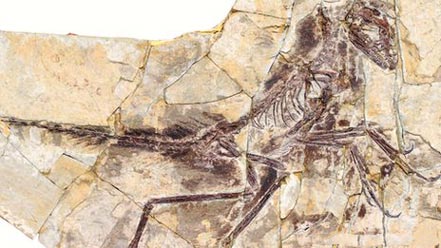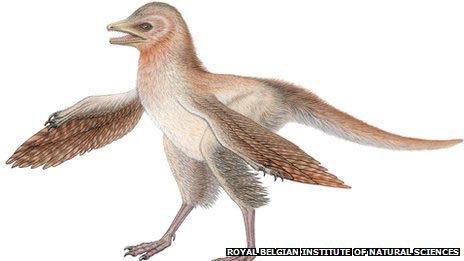New Dinosaur Discovery Challenges the Theory of Bird Evolution
A single, thirty-centimetre-long fossil of a dinosaur from China is helping palaeontologists to understand a little more about the complex evolutionary path between the Dinosauria and Aves (birds), the fossil, representing a new genus of basal troodontid has been named Eosinopteryx brevipenna. This dinosaur lived in a swampy environment with plenty of tree cover. The discovery of this fossil increases the known diversity of small-bodied, feathered dinosaurs that lived during the Middle to Late Jurassic and shows that a number of different taxa of feathered, mainly cursorial dinosaurs occupied different niches in dinosaur dominated ecosystems suggesting that the evolution of flight and ultimately the Class Aves is much more complex than was thought some twenty years ago.
Eosinopteryx brevipenna
Archaeopteryx (A. lithographica) may be regarded as a transitional fossil between the Dinosauria and true birds, but it seems that the Late Jurassic feathered dinosaur from finely grained limestone deposits of Solnhofen in Germany may only represent one of a number of dinosaur lineages that had feathers.
This new fossil discovery comes from the Tiaojishan Formation of western Liaoning, a Province in China. The strata of the Tiaojishan Formation has been dated to around 165 -155 million years ago (Early Bathonian to Mid Oxfordian faunal stage). The specimen represents an adult or possibly a sub-adult specimen and an analysis of the well-preserved fossil shows that this little dinosaur had a short snout, quite large eyes, small arms covered in short feathers and toes suited to running (cursorial lifestyle).
E. brevipenna had fewer feathers on its tail and lower legs, these adaptations would have made it easier to run. It can be speculated that this feathered dinosaur probably hunted insects, lizards and small mammals in the undergrowth. An anatomical study of the bone structure of the arms of this reptile suggest that it could not fly, the feathers may have aided the animal jumping from logs and other obstacles, perhaps acting as mini air brakes to help control landing. The genus name Eosinopteryx means “Early Chinese Feather”.
The Fossil Specimen (Eosinopteryx brevipenna)
Picture credit: Macmillan Publishing
One of the co-authors of the scientific paper (published in the academic journal “Nature Communications”), Dr Gareth Dyke from the University of Southampton commented that:
“This discovery sheds further doubt on the theory that the famous fossil Archaeopteryx – or “first bird” as it is sometimes referred to – was pivotal in the evolution of modern bird.”
Bird Evolution
The team’s findings suggest that the origin of flight was much more complex than was thought twenty years ago, with there being a lot of evidence to suggest that there were a number of feathered, cursorial dinosaur genera present in the Middle to Late Jurassic. Interestingly, the rocks of the western part of Liaoning Province have provided a substantial number of pterosaur fossils. In this part of China towards the end of the Jurassic there were a lot of reptiles that were very accomplished fliers – members of the Pterosauria.
One such genus is Darwinopterus (named after the naturalist Charles Darwin). Known from around forty fossil specimens including one that showed an egg about to be laid but still present in the animal’s body, this pterosaur genus shows important anatomical characteristics that suggests it may be a transitional form from the primitive rhamphorhynchoid pterosaurs to the more advanced, shorter-tailed pterodactyloid pterosaurs.
To read an article on Darwinopterus: Pterosaur Transitional Fossil – Darwinopterus.
An Illustration of Eosinopteryx brevipenna
Picture credit: Royal Belgian Institute of Natural Sciences
Liaoning Province may be famous for its feathered fossils representing creatures from the Early Cretaceous but it also seems that the older strata of this part of China can lay claim to a number of feathered dinosaur fossils too.
To view models and replicas of early birds and feathered dinosaurs: PNSO Age of Dinosaurs Models and Replicas.







Leave A Comment